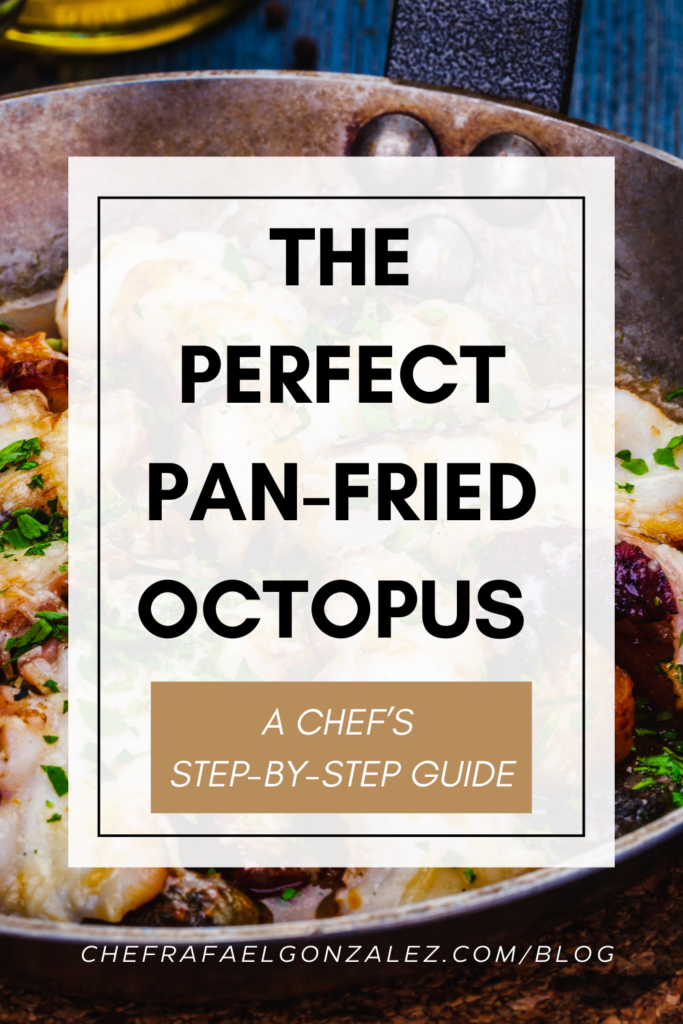
The Art of Pan-Frying Octopus
After long hours in the kitchen as a young cook in early 2000, I would often unwind by visiting the local bars in and around San Sebastian and Barcelona. It was there that I first tried octopus, and from that moment, it became one of my all-time favorite recipes.
Having lived in Spain before and after working with Chef Jean-Georges Vongerichten in New York City, I developed a deep appreciation for the art of pan-frying octopus. The tender, meaty texture and delicious flavor that this cooking method brings out in octopus are unmatched. Whether it’s at a restaurant or in the comfort of our own kitchen, we find that pan-frying always brings the best out of this seafood delicacy.
Why Choose Pan-Frying?
The sizzle of hot oil creates a golden brown crust, giving the tender octopus a crispy outer texture you can’t resist. Unlike simmering or braising, pan-frying enhances the flavor and meaty texture of the cephalopod, making it an ideal method for this beloved seafood.
We’ve found that with the right heat and oil, pan-frying brings out the best in octopus, locking in its natural juiciness and unique taste. The process is similar to pan-searing but incorporates just a bit more oil, allowing the octopus pieces to cook to perfection.
The result is a truly tasty octopus dish that offers the perfect balance of tender interior and crispy exterior.
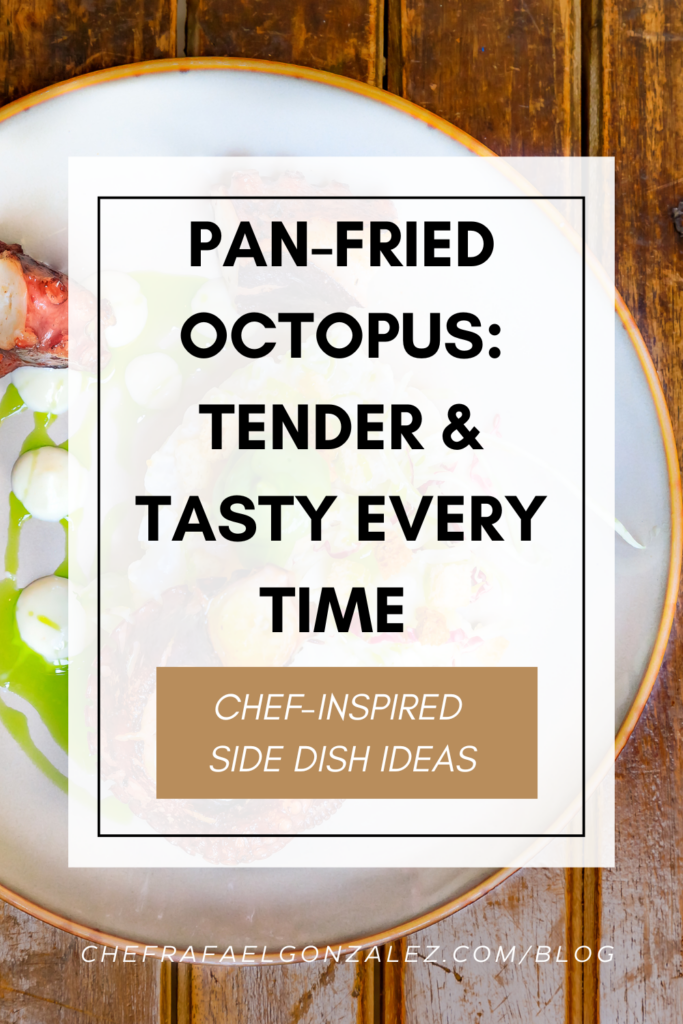
Selecting Your Octopus
Whether opting for fresh or frozen octopus, it must meet certain criteria to ensure a delightful taste and texture. At the seafood market or grocery store, the first step is to look for octopus with firm and glossy skin, a sign of freshness.
When selecting a size, consider a larger octopus for a more meaty texture, suitable for pan-frying. Its tenderness is key—fresher octopus tends to be more tender after cooking. For the best results, it’s essential to pick the prime specimen: neither too small nor too tough.
We always opt for the freshest octopus available—whether it means procuring it from the local seafood market or selecting a premium package from the grocery store freezer section. This meticulous attention to detail ensures that our pan-fried octopus turns out nothing short of perfection.
Want our secret? We get the cooked octopus from Costco. Thaw it in a large bowl and bring it to room temperature.
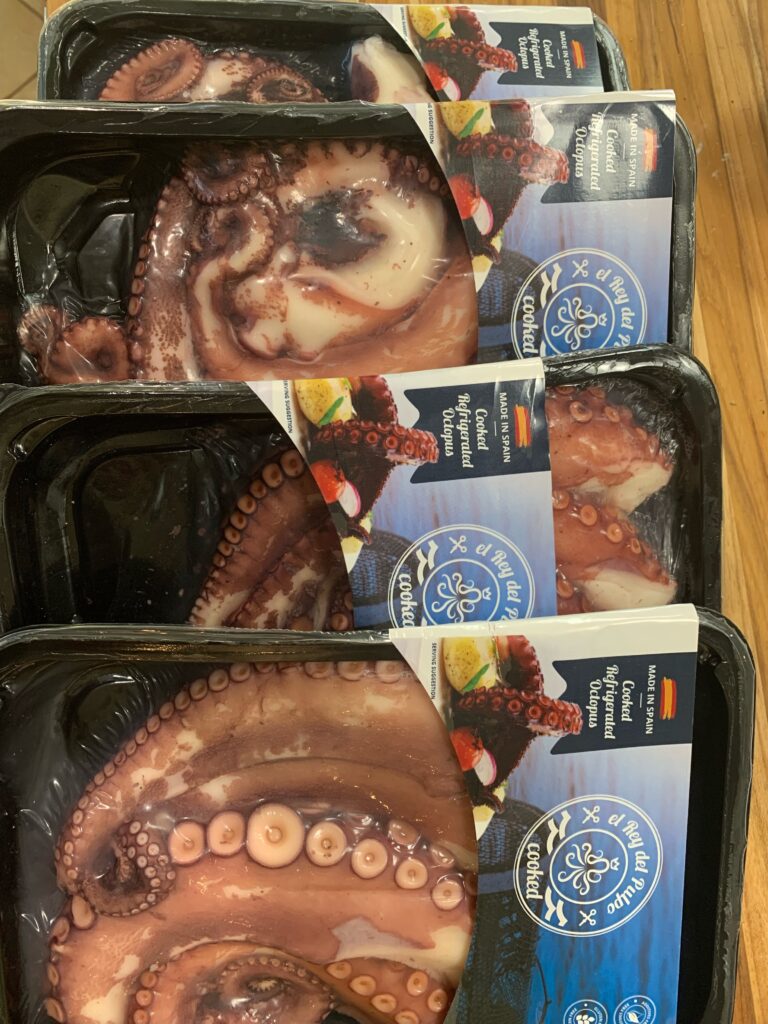
One of the best things about choosing the large octopus from Costco as opposed to the fresh octopus from your seafood monger is that the octopus is already cooked. You’re skipping a step because that’s already boiled octopus that you just purchased.
And one more thing you might now know.
Once you tenderize the fresh octopus after simmering, the size of that octopus shrinks by almost one half!
Preparing Octopus for Pan-Frying (Simmer First)
This is crucial for achieving a softer texture, so don’t rush this part. Begin by simmering the octopus in a pot of water. Once it’s fork-tender, it’s ready for the next step.
Pat dry the octopus with paper towels to absorb the moisture.
Now, it’s time to prepare the octopus for pan-frying. Start by cutting the octopus into pieces suitable for frying. We prefer smaller pieces to ensure even cooking and a crispy outer texture.
Cutting the octopus also helps the flavors penetrate the meat, making every bite as delicious as the next.
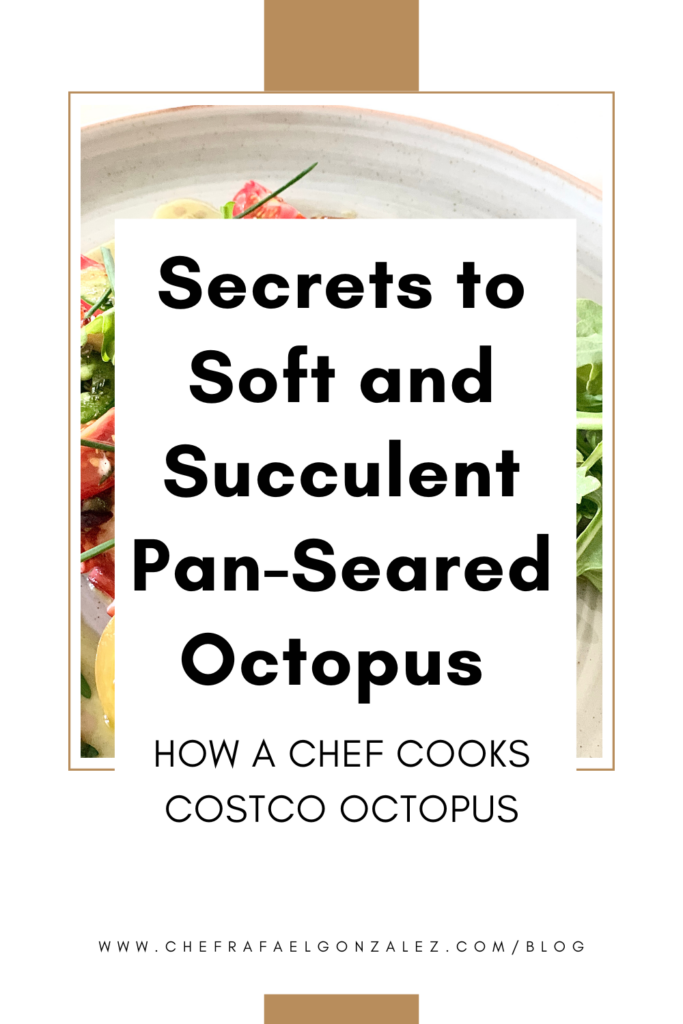
Choosing the Right Oil
For pan-frying octopus, we recommend using grapeseed oil for its high smoke point and neutral flavor. This ensures that the oil won’t burn at the recommended medium-high heat, allowing the octopus to attain a delicious crispy outer texture.
However, if you prefer a more distinct flavor, olive oil adds a delightful depth to the dish. Just keep an eye on the oil’s temperature and adjust the heat as needed to prevent the olive oil from reaching its smoke point.
As for the amount of oil, a medium layer in the pan is usually sufficient. It’s important to ensure there’s enough to cover the octopus pieces partially, allowing them to cook evenly and develop that irresistible crunch.
Getting the Pan Ready
Use a frying pan or a large skillet based on the size of your octopus pieces. You want to bring your oil to medium high heat. To test if the pan is ready, sprinkle a few drops of water into it. If they sizzle and evaporate, the pan is at the perfect temperature for frying.
The Frying Process
As it warms up, add the grapeseed oil or vegetable oil and let it reach the right temperature.
Step 2: Place the octopus pieces in the pan, ensuring they are not overcrowded. Let them cook for 3-4 minutes until the bottom turns a golden brown color.
Step 3: Carefully flip the octopus pieces using tongs to cook the other side for an additional 3-4 minutes. A crispy outer texture will start to develop.
Step 4: Test the doneness by poking the thickest part of the octopus with a fork. It should feel tender and have a golden brown crust.
Remember, the key to perfectly pan-fried octopus is to avoid overcrowding the pan, allowing each piece to cook evenly and develop that crispy outer texture. With these simple steps, you can achieve a mouthwatering, tasty octopus, ready to be served as a main dish or a perfect appetizer.
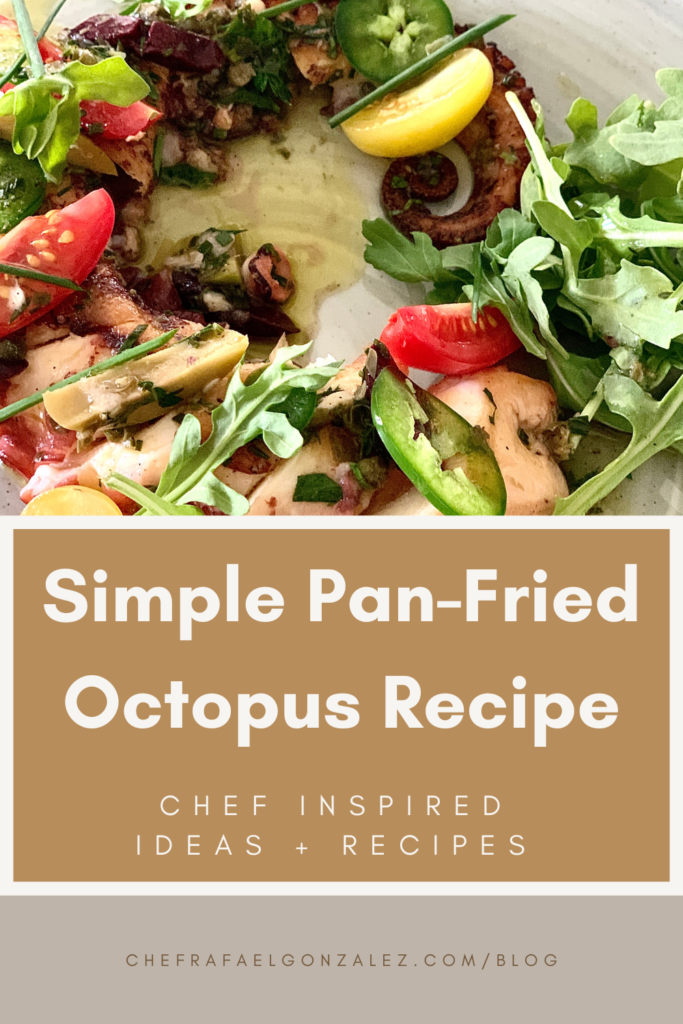
Seasoning Your Octopus
A drizzle of freshly squeezed lemon juice adds a zesty tang that highlights the natural taste of the octopus. We often toss a bay leaf or two during the cooking process to infuse a subtle, earthy aroma into the meat.
For those who enjoy a hint of heat, a sprinkle of cayenne pepper or black peppercorns does the trick, adding a gentle kick without overpowering the dish.
We find that adding these seasonings towards the end of the cooking process really allows their flavors to meld with the meat, creating a perfect balance that complements the natural taste of the octopus.
Serving Your Pan-Fried Octopus
Create a stunning presentation by arranging the golden brown octopus pieces on a bed of crisp greens, such as arugula or watercress. The vibrant colors and flavors will elevate the dish to a whole new level of culinary artistry.
Add a burst of freshness with a side of cool cucumber and tomato salad, dressed in a zesty vinaigrette. The contrasting textures and flavors will dance on your palate with each savory bite.
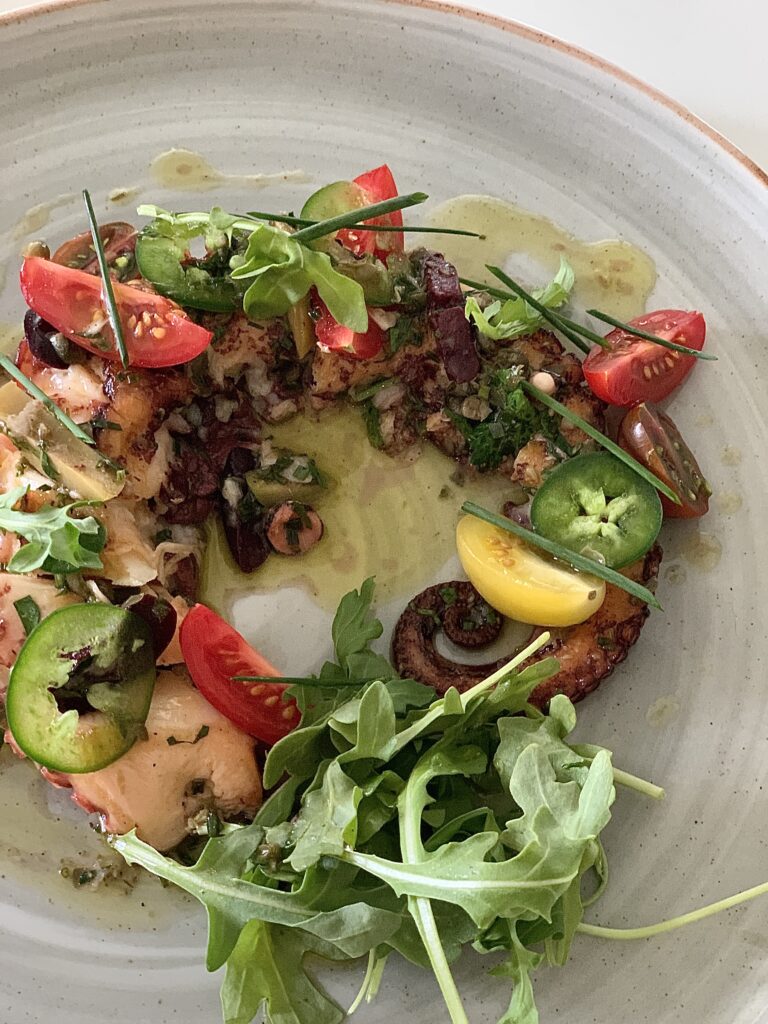
For an even richer experience, consider serving a warm, buttery new potato salad as a hearty accompaniment to the crispy octopus.
To enhance the taste, don’t forget to garnish the dish with a generous squeeze of zesty lemon juice and a few wedges on the side for that final, tangy touch. The citrusy note will complement the savory flavors of the octopus, leaving a lingering taste of the sea on your tongue.
Remember, the key to serving pan-fried octopus is to let your creativity flow, whether it’s a splash of vibrant sauces, a sprinkle of fresh herbs and a lemon wedge for a truly mesmerizing presentation.
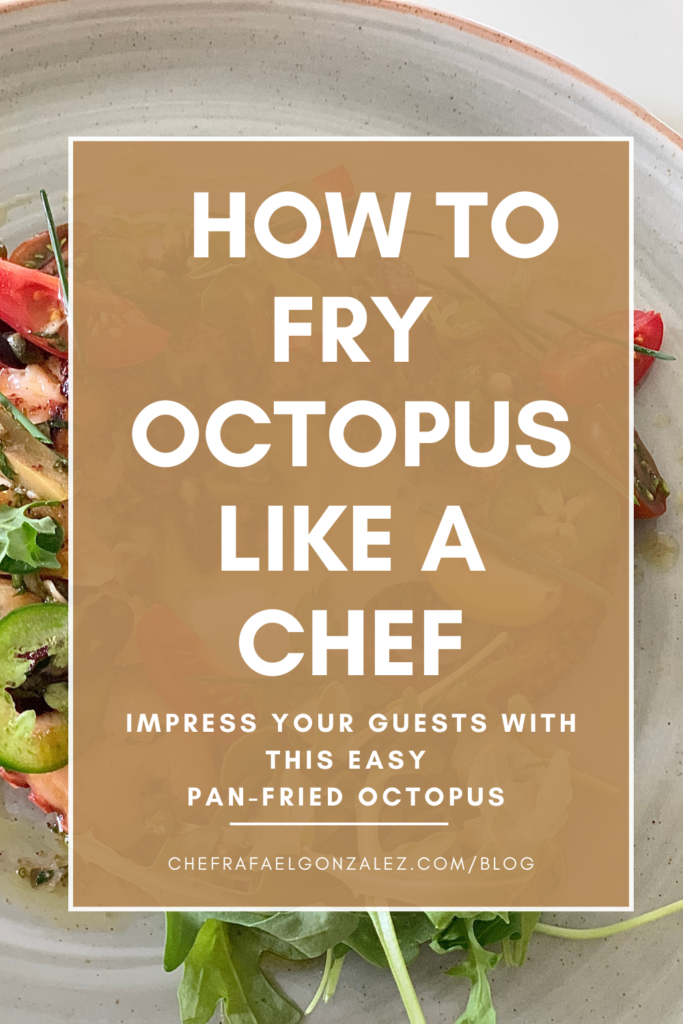
Storing Leftover Fried Octopus
To maintain its meaty texture and delicious taste, store the cooled leftover fried octopus in an airtight container in the refrigerator. When properly stored, it stays good for up to two days.
Reheating your leftover octopus is simple; gently warm it in a preheated oven at 350°F for about 10 minutes.
This method helps to preserve its crispy outer texture while ensuring the inside remains tender. Avoid using the microwave, as it may compromise the delightful texture we’ve worked so hard to achieve.
Leftover fried octopus opens up a world of culinary possibilities. You can use it to top salads, as a savory addition to pasta dishes, or even as a flavorful filling for tacos. You can even make a Mexican seafood cocktail called a campachena using octopus.
Feel free to get creative and experiment with various recipes to make the most of your delicious leftover fried octopus.
Expert Tips for Perfect Results
Taking the time to tenderize the meat and achieve the right texture is crucial. You must boil the fresh octopus until tender before pan-frying.
If you want to save on time and if you’re lucky to have a Costco nearby, stock up on the octopus! Trader Joes also carries them, but they are seasonal.
Experiment with heat and cooking times based on the size of your octopus. Adjust the temperature and duration to find the sweet spot for that tender, meaty texture we all love.
Don’t rush the process. Achieving the perfect golden brown crust and a deliciously tender octopus takes time, but the results are worth the wait.
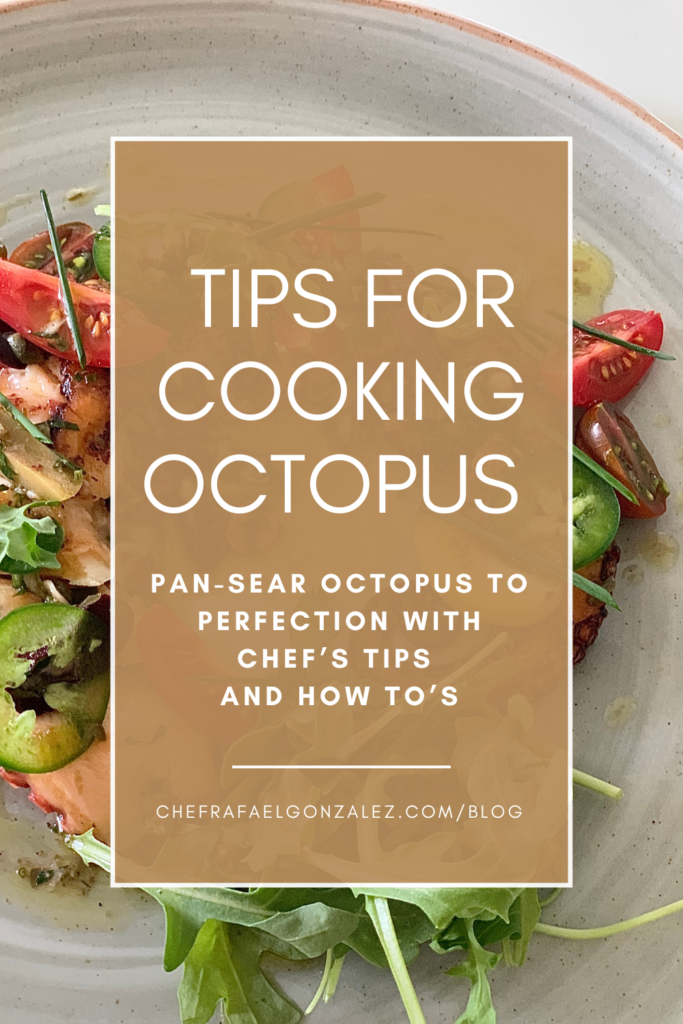
Troubleshooting Common Issues
This issue typically occurs when the octopus is not properly tenderized during the initial boiling or braising process.
To avoid this bubble gum chewy texture, ensure that the octopus is simmered in low heat until it becomes tender, which can take around 30-40 minutes, depending on the size of the octopus. Patience during this step is key to achieving the best texture.
Another issue that may arise is the octopus not crisping up and achieving that golden brown color. This can occur if the oil temperature is too low or if the octopus pieces are overcrowding the pan. To solve this, make sure the oil is at the right temperature, which is around medium-high heat.
Also, ensure that the pieces of octopus are not overcrowding the grill pan, allowing them to fry evenly and achieve that desirable crispy outer texture.
Wrapping Up the Tentacles, You’re Done!
Literally a wrap!
You’ve now uncovered the secret to achieving the perfect pan-fried octopus. Mastering the art of pan-frying octopus has been a culinary journey close to our hearts, from the local bars of southern Spain to the comfort of our own kitchen.
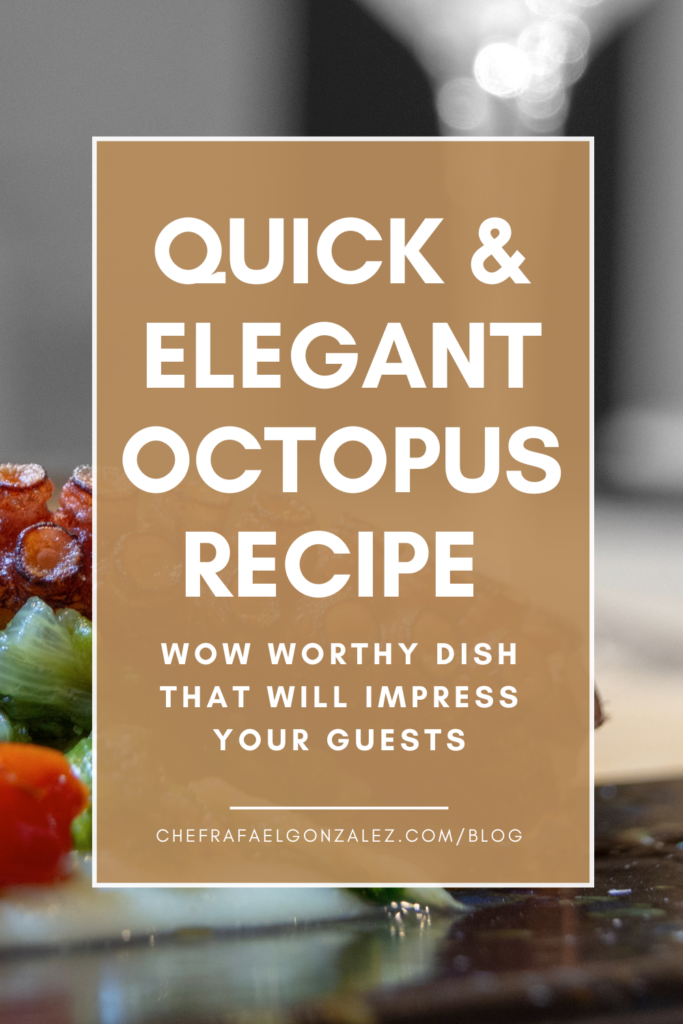
Whether you’re a seasoned cook or just beginning to explore the culinary world, there’s nothing quite like the joy of creating a tasty octopus dish.
We’re genuinely excited about the possibility of you experiencing the same satisfaction and delicious flavors that have become a staple in our kitchen. We look forward to hearing about your own pan-frying escapades and the successes you achieve with this recipe.
Hungry for More?
If you’ve enjoyed learning about the pan-frying procedure for octopus, why not take your culinary skills a step further? Watch our YouTube video right HERE so you can see how easy it is to whip up a Mediterranean pan seared octopus right in your own home.
Read our previous blog post with the recipe for octopus HERE.
If you looooove octopus like we do, you’re in for a treat. We’re getting ready to put together a mini-course on octopus. We’ll share recipes from Greece, Italy, Mexico and Japan, offering you a diverse options of flavors and techniques to explore.
Your taste buds will thank you!
Whether you’re craving Mediterranean freshness, Italian sophistication, or the vibrant spices of Mexican and Asian cuisine, we’ve got you covered.
The best part about all of this?
All of these recipes take just about 30 minutes to prepare, making them perfect for busy weeknights or leisurely weekends.
Expand your culinary horizons and discover the versatility of octopus with our exclusive recipes.
Sign up to be included in our list now (it’s FREE) so you can stay in the loop and elevate your dining experience.
Be the first to comment